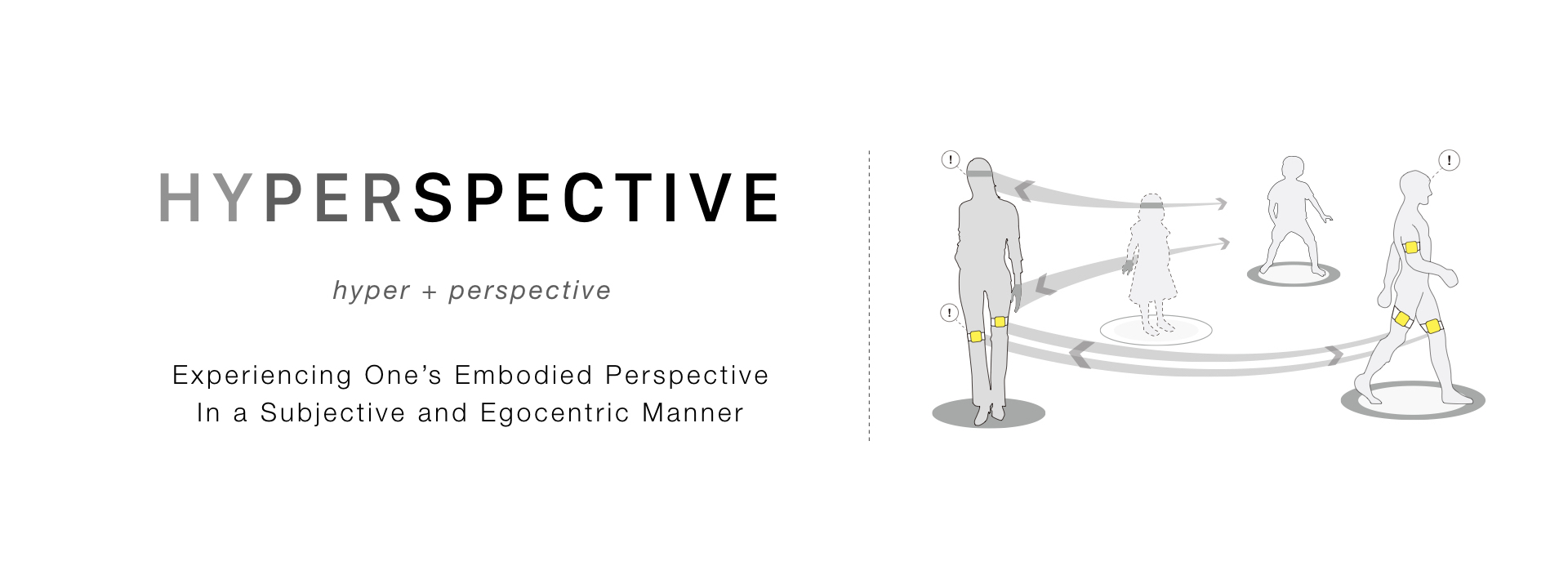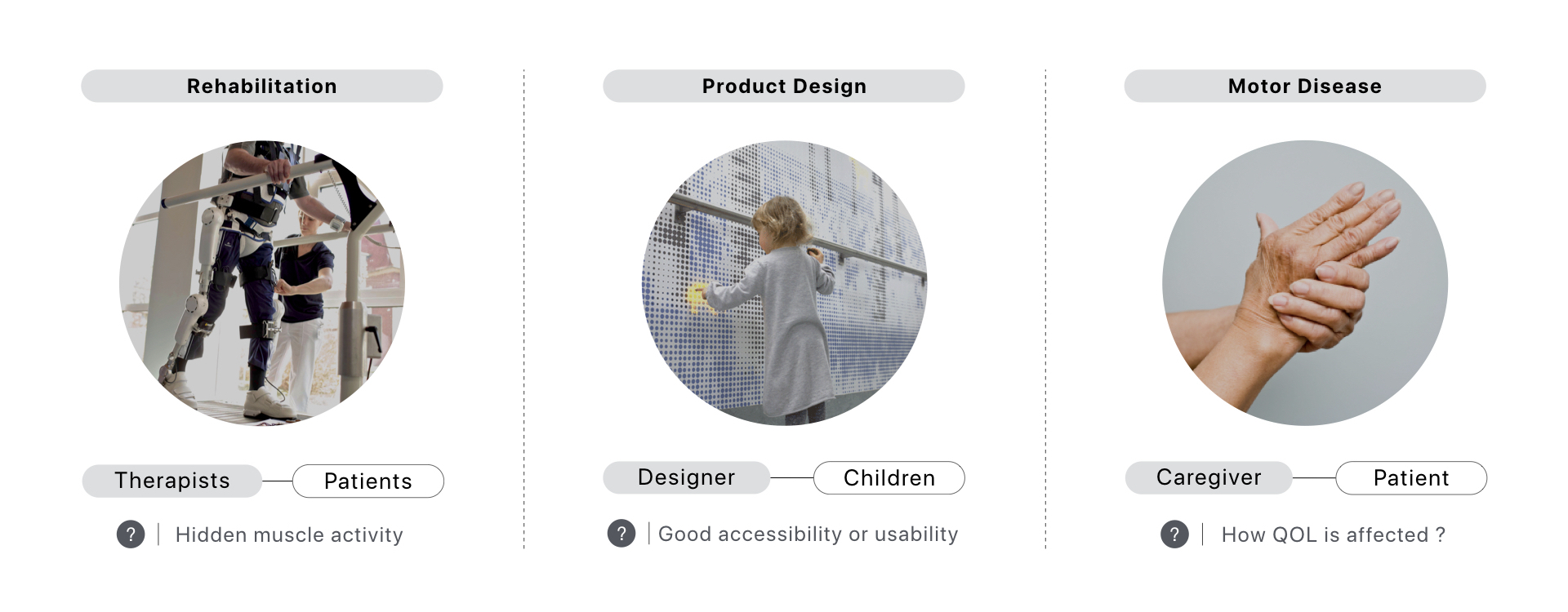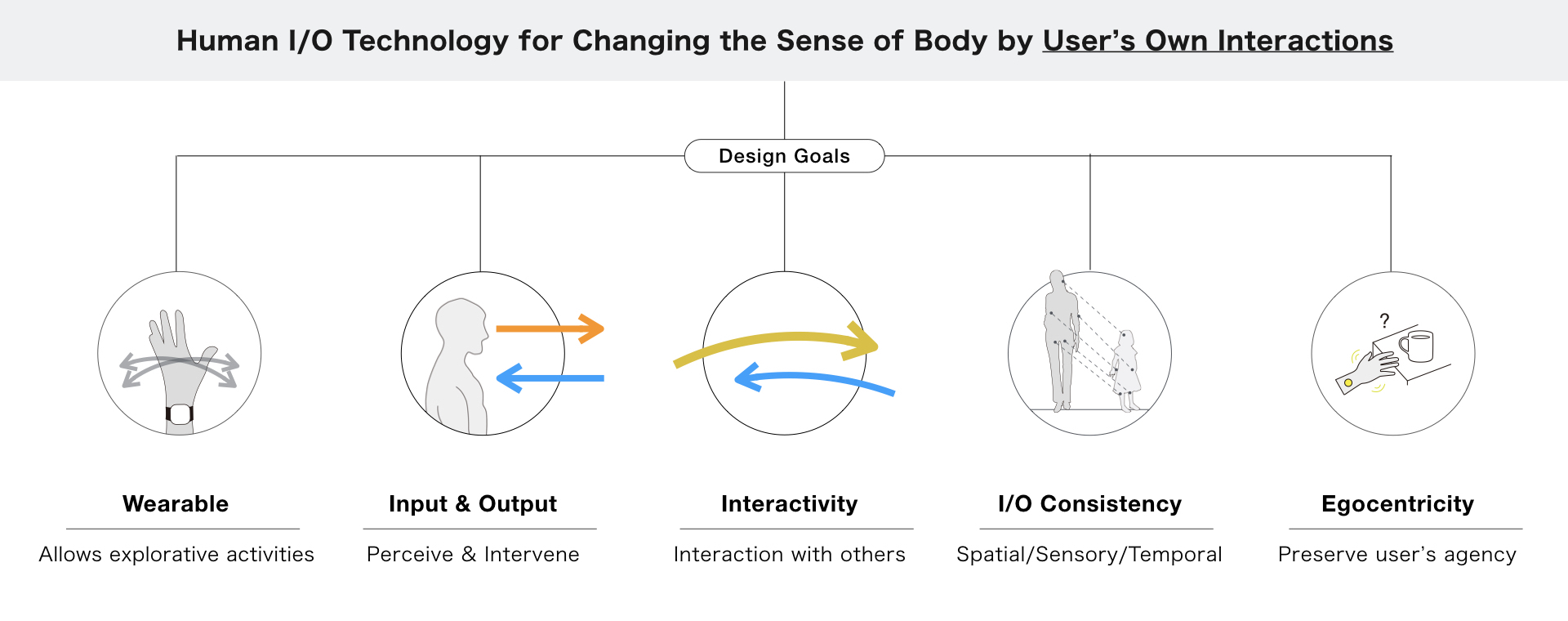Vision
Changing Perspectives by Wearable Devices
for Minding the Embodied and Cognitive Gaps in the fields of Rehabilitation, Education, and Design
In the field of rehabilitation, it is important to share kinesthetic information, such as muscle activity which is hardly observed by visual sensation, between a physical therapist and a patient. For product designers and nursing teachers, it would be valuable embodied experience to see and explore classrooms or hospital space from a child’s lower stature. We never know how Parkinson’s patients manage eating utensils with hand tremors. These embodied experiences are usually difficult to be fully transferred to or reproduced on another person through conversations or visual materials.
In order to assist in understanding one’s physical and cognitive characteristics in an embodied manner, we aim to establish an environment in our body in which a learner can acquire one’s embodied perspective based on the learner’s active interactions in a real world, rather than presenting one’s embodied information on a computer screen. To achieve this concept, I have developed several wearable devices such as:
1) a wearable Augmented Reality device which provides a child’s visual perspective by modifying the wearer’s height of line of sight;
2) a pair of hand exoskeletons which provides a child’s haptic perspective by scaling down the wearer’s hand dimension;
3) a pair of wearable stimulation devices which provides a patient’s kinesthetic perspective by sharing muscle activity, such as Parkinson’s tremor, among people.
Cooperate with People by Sharing Abilities
These devices allow the wearers to acquire one’s embodied perspective from their subjective and active experiences by modifying their bodily sensation. I define these embodied and subjective perspectives as HYPERSPECTIVE (hyper + perspective). I explore hyperspective technologies for assisting mutual understanding and cooperation among people in the fields of rehabilitation, education, and design, and would like to contribute to the establishment of an infrastructure, in which all people, with or without disabilities, can maximize/share their own abilities and support/cooperate with each other.
Publications
Jun Nishida, “Wearable Empathy: Feeling How Others’ Bodies Interact Can Change Your Perspective”, ACM UIST Medium, 2020 (web)
Jun Nishida and Kenji Suzuki, “HYPERSPECTIVE: Shaping Experiences beyond Perspectives”, IEEE VR 2019 Workshop on Human Augmentation and its Applications, 2019 (pdf)
Jun Nishida, “Shaping Egocentric Experiences with Wearable Cybernic Interfaces”, PhD Thesis Abstract, 2019 (pdf)
Jun Nishida, “HYPERSPECTIVE: Changing Perspectives by Wearable I/O Devices to Understand, Communicate and Cooperate with People”, Dagstuhl Seminar “Human-Computer Integration”, 2018 (pdf)
Robb Mitchell, Jun Nishida, Enrique Encinas and Shunichi Kasahara, “We-Coupling! Designing New Forms of Embodied Interpersonal Connection”, ACM TEI Studio, 2017 (pdf)
Jun Nishida, “Empowered Human”, 2017 GCR Hackathon Workshop Series 2016 Microsoft Hackathon Highlight Projects Sharing, Beijing, Jul. 2017
Forbes Japan 編集部, “身体をハックするテクノロジーで「人類の想像力」を拡張せよ”, Forbes Japan 30 Under 30 西田惇, Forbes Japan, 2018 (web)
伴 碧, 高橋 英之, 細田 耕, 鳴海 拓志, 西田 惇, 福島 宏器, “日常体験を記述せずに科学する方法論の新展開 -心理学と最先端テクノロジーとの対話-“, 日本心理学会公募シンポジウム, SS-095, 2017 (web)
西田惇,”装着型機器による身体認知機能の最大化に基づく人々のエンパワーメント “, 総務省異能vation審査会, Sept. 2017
西田惇,鈴木健嗣, “他者の身体・認知特性の理解を支援するウェアラブルデバイス”, つくば医工連携フォーラム, つくば, Jan. 2017
西田惇,”インタラクションの拡張に基づく気づき・デザイン・リハビリテーションの支援”, 産業技術総合研究所デジタルヒューマンリサーチグループ セミナー, 東京, Dec.7, 2015



